TO
| Title | Date | Subject | Description | ||
|---|---|---|---|---|---|
| 51 |
 |
DOE project review: Subtask 4.2 (B): Examination of in situ production models | 2011-03-11 | DOE project review; in situ production models; oil shale; unconventional fuels; oil sands; geomechanics; general reservoir simulation tool | A presentation given at the Unconventional Fuels from Oil Shale and Oil Sands Project Review Meeting on March 10-11, 2011. The objectives of the presentation is the examination of in-situ production methods, different in-situ production method options, rigorous energy and carbon balances, exploratio... |
| 52 |
 |
ASCRS/ESCRS Survey on Foldable IOLs Requiring Explantation or Secondary Intervention 2005 Update | 2006-03-16 | ASCRS; ESCRS; Survey; Foldable IOLs | This presentation provides updates on ASCRS/ESCRS Survey on Foldable IOLs Requiring Explantation or Secondary Intervention |
| 53 |
 |
A generational Shift | The original first generation elevated low-pressure flare technology is a simple pipe flare. While still broadly used today, these 1G flares tend to smoke easily even with the lightest of hydrocarbons, methane. | ||
| 54 |
 |
Process Burner Tiles | Many people think that the burner tile is simply a piece of refractory or firebrick. Nothing could be further from the truth! The burner tile is the "heart" of the burner. Tile that has not been poured correctly, installed correctly, or that has not been properly maintained can have a serious impact... | ||
| 55 |
 |
Utah energy: Perspective on unconventional fuels development | 2010-04-28 | Utah energy; oil shale basins; unconventional fuels. | Utah energy goals: 1) Affordable energy 2) Sustainable economy 3) Strengthen energy security and independence 4) Reduce emissions |
| 56 |
 |
A market assessment of heavy oil, oil sands, and oil shale resources | 2011-03-10 | unconventional fuels; market assessment; developing domestic heavy oil, oil sands, and oil shale resources; preliminary infrastructure needs | A presentation given at the Unconventional Fuels from Oil Shale and Oil Sands Project Review Meeting on March 10-11, 2011. |
| 57 |
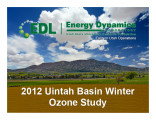 |
2012 Uintah Basin winter ozone study | 2012-05-15 | Uintah Basin; winter ozone; wintertime ozone formation; episodic ozone formation; high wintertime ozone | This is a presentation given at the 2012 University of Utah Unconventional Fuels Conference. |
| 58 |
 |
2012 Unconventional fuels conference introduction | 2012-05-15 | unconventional fuels; computational simulation and pilot-scale experiment; unconventional resources; emissions minimization; CO2 regulation; CO2 coal research | Presentation given at the 2012 Unconventional Fuels Conference. |
| 59 |
 |
Policy analysis of the Canadian oil sands experience | 2011-03-10 | policy analysis; Canadian oil sands experience; oil sands; federal oil sands resources; oil sands development; unconventional fuels | The presentation goes over analyzing the relevance of the Canadian experience to U. S. oil sands development. This report focuses on federal oil sands resources, specifically potential development in the STSA's. No Current development on federal lands, despite leasing authorization under the Combine... |
| 60 |
 |
Unconventional fuels development and the environment | 2011-05-17 | Unconventional Fuels; development and environment; Uinta Basin case; indian country regulatory juristiction; clean air act; clean water act; Uinta Basin; NEPA; regulatory process | Presentation given at the 2011 Unconventional Fuels Conference. |
| 61 |
 |
Unconventional Fuels Conference: Oil shale and oil sands development in the western U. S. - Agenda | 2013-05-07 | unconventional fuels; oil shale development; oil sands development; agenda | Presentation given at the 2013 Unconventional Fuels Conference. |
| 62 |
 |
Wild lands and wilderness - Implications for Utah's unconventional fuels industry | 2011-05-17 | unconventional fuels industry; order 3310; maintain wilderness resource inventories; BLM; FLPMA; land management | Presentation given at the 2011 Unconventional Fuels Conference. |
| 63 |
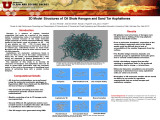 |
Atomistic modeling of oil shale kerogen and asphaltenes | 2010-04-28 | Kerogen is a mixture of organic chemical compounds that make up a portion of the organic matter in sedimentary rocks. It is insoluble in normal organic solvents because of the large molecular weight (upwards of several thousand Daltons). When heated in the Earth's crust (oil window ca. 60 ° - 120 �... | |
| 64 |
 |
Economic, repeatable and environmentally responsible | 2012-05-15 | unconventional fuels; U.S. oil sands; oil sand; bitumen | This presentation and the Company's website referenced in this presentation contain forward-looking statements including expectations of future production and components of cash flow and earnings. Investors are cautioned that assumptions used in the preparation of such information may prove to be in... |
| 65 |
 |
Division of oil, gas, and mining permitting processes | 2011-05-17 | permitting processes; natural resources; oil; gas; mining | Division of Oil, Gas, and Mining Permitting Processes. John Baza, DirectorUtah Division ofOil, Gas and Mining. Unconventional Fuels Conference. May 17, 2011 |
| 66 |
 |
Digital library and interactive map projects at the Institute for Clean and Secure Energy, University of Utah | 2009-10-23 | ICSE; digital repository | The Instituteʼs repository is a not-for-profit service for researchers, and we are working to include a variety of documents, data, and maps relevant to unconventional fuels research and development. |
| 67 |
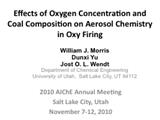 |
Effects of oxygen concentration and coal composition on aerosol chemistry in oxy firing | 2010-11-12 | aerosol chemistry; oxy firing; ICSE; coal aerosols; coal composition | Outline: 1) Objectives 2) Coals examined 3) Furnace, sampling, and analysis 4) Results 5) Conclusions. The objectives of the presentation is to provide a comparison of three different coal aerosols under two different oxy fired scenarios for predicting effects of coal composition on oxy firing. Exam... |
| 68 |
 |
Federal oil shale development: Status of Bureau of Land Management oil shale activities | 2011-05-17 | oil shale development; oil shale; land management; Bureau of Land Management; domestic oil shale | |
| 69 |
 |
Ignition in 40kw co-axial turbulent diffusion oxy-coal jet flames | 2010-08-08 | 40kw co-axial turbulent diffusion; diffusion; oxy-coal; oxy-coal jet flames; partial pressure of O2; coal transport | Outline: 1) Introduction 2) Objectives 3) Experimental setup 4) Methodology to quantify flame stability 5) Results and discussion 6) Conclusions 7) Acknowledgements. The objective of this presentation is to better understand, the effects of partial pressure of O2 in a) the coal transport jet, and b)... |
| 70 |
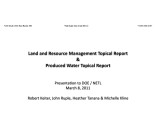 |
Land and resource management topical report and produced water topical report | 2011-03-08 | water topical report; land management; resource management; oil sands; oil shale | |
| 71 |
 |
Introduction to Enefit | 2011-05-17 | Enefit; oil shale; mining; power generation; oil shale production | Contents 1.Enefit Overview 2.Enefit280 Process 3.Enefit Outotec Technology JV 4.Enefit Activities in Estonia 5.Enefit American Oil |
| 72 |
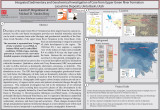 |
Integrated Sedimentary and Geochemical Investigation of Core from Upper Green River Formation Lacustrine Deposits, Uinta Basin, Utah | 2011-05-17 | geochemical investigation; Green RIver; oil shale; lacustrine deposits | Description of the upper Green River Formation has been largely based on outcrop exposures, but this core-based investigation provides new detailed subsurface data that can be used to examine basin-wide lithologic and geochemical variability of the Parachute Creek Member of the upper Green River For... |
| 73 |
 |
ASCRS/ESCRS Survey on Foldable IOLs Requiring Explantation or Secondary Intervention 2005 Update | 2006-03-16 | ASCRS; ESCRS; Survey; Foldable IOLs | A 2005 presentation with the Intermountain Ocular Research Center of the University of Utah on the complications of IOL removal. |
| 74 |
 |
OCT and Retinal Architecture | 2006-11-07 | Optical Coherence Tomography; Retina; Diagnosis | This presentation discusses Optical Coherence tomography, a diagnostic tool used in ophthalmology to produce a relatively high resolution image: 2 mm deep, cross-section rendition of the retina. |
| 75 |
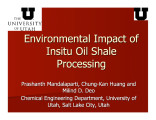 |
Environmental impact of in-situ oil shale processing | 2007-10 | in situ processing of oil shale; in situ processing; oil shale; production of oil from kerogen; oil production | The in situ processing of oil shale for the production of oil from the kerogen involves heating the shale slowly to moderate temperatures of between 3000 C and 4000 C. At this temperature, gaseous products that evolve from the oil shale are condensed and recovered. The pathways of creation of oil fr... |
